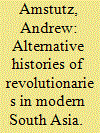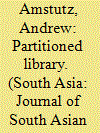|
|
|
Sort Order |
|
|
|
Items / Page
|
|
|
|
|
|
|
| Srl | Item |
| 1 |
ID:
167569


|
|
|
|
|
| Summary/Abstract |
This review essay discusses two recent monographs on revolutionaries and political violence in South Asia, Kama Maclean’s A Revolutionary History of Interwar India: Violence, Image, Voice and Text (2015) and Durba Ghosh’s Gentlemanly Terrorists: Political Violence and the Colonial State in India, 1919-1947 (2017). Ghosh and Maclean’s books contribute to an expanding body of scholarly work on anticolonial politics in India, a rich historiography on liberalism in the British Empire, and studies of visual culture and oral histories in modern South Asia. Specifically, Maclean’s A Revolutionary History centers on the Hindustan Socialist Republican Army (HSRA) in Punjab and Delhi in the late 1920s and early 1930s. Maclean reconfigures the political terrain of India’s independence struggle and illustrates the importance of revolutionary violence in nonviolent politics through unstudied visual sources and oral histories. In turn, Ghosh’s Gentlemanly Terrorists focuses on Bengal, particularly revolutionaries in the Anushilan Samiti and Jugantar from 1919 to 1947. Complicating the history of colonial constitutionalism as a gradual expansion of rights and representation, Ghosh demonstrates how constitutional reforms that aimed to promote liberal governance in India were tied to repressive emergency legislation. This review essay addresses how Gentlemanly Terrorists and A Revolutionary History contribute to ongoing efforts to rethink both the political chronology and the wider political landscape of interwar India by incorporating revolutionaries into the story of independence. It also considers how Maclean and Ghosh creatively utilize non-state archives and vernacular sources, in conjunction with colonial records, to follow the retelling of revolutionary histories in different media.
|
|
|
|
|
|
|
|
|
|
|
|
|
|
|
|
| 2 |
ID:
125668


|
|
|
|
|
| Publication |
2013.
|
| Summary/Abstract |
This article examines the depiction of women and gender within Coptic Orthodox video films or "hagiopics" produced between 1987 and 2010. As part of a recent religious renewal, hagiopics have expanded, altered, and reinvented traditional stories of saints and pious figures and have also generated, within this traditionally patriarchal setting, a wider space for the articulation of female voices. While their inclusion can be seen as potentially empowering for women, this paper suggests that during Pope Shenouda III's reign (1971-2012), the films became a powerful vehicle for broadcasting the church's conservative teachings on female power and authority, marriage and marital dissolution, spousal abuse, and femininity. By highlighting an array of exemplary female characters, hagiopics capture women's role as custodians of a distinctive Coptic ethos and of family and communal cohesiveness. The films' emphasis on women's physical modesty, submissiveness, and obedience to male figureheads also hints at the modern church's anxieties about women's increasing autonomy in choosing marriage partners and their growing demands for more equal treatment within the church.
|
|
|
|
|
|
|
|
|
|
|
|
|
|
|
|
| 3 |
ID:
165931


|
|
|
|
|
| Summary/Abstract |
This article explores the surprising role of the ancient Buddhist past in the construction of Pakistani national histories in museum exhibits and archaeological guides from 1950 to 1969. Although Pakistan was created as a homeland for Indian Muslims during the 1947 Partition of British India, Pakistani historians struggled to forge a unifying history for the new Muslim nation-state through Islam. In response, Pakistani museum curators co-opted and reframed Buddhist sculptures from before the arrival of Islam to differentiate Pakistan from India and to make sense of Pakistan’s recently drawn borders. They creatively retold the history of ancient Gandhara (first century BCE to fifth century CE), a Buddhist kingdom in northwest Pakistan and Afghanistan, to provide deep historical logic for Pakistan’s existence as a religious homeland in the mid twentieth century and to build global cultural connections to Southeast Asia and to Europe.
|
|
|
|
|
|
|
|
|
|
|
|
|
|
|
|
| 4 |
ID:
172227


|
|
|
|
|
| Summary/Abstract |
This article argues that the history of a damaged Urdu library in Delhi reveals new perspectives on the ways in which prominent Indian Muslim scholars dealt with the violent displacements of the 1947 Partition of British India and imagined new futures for the Urdu language across the borders of India and Pakistan. The library of the Anjuman-e Taraqqi-e Urdu (Association for the Advancement of Urdu), an influential Urdu literary association, was damaged during the violence following Partition in August 1947. In contrast to the relative absence of official commemorations of Partition in post-colonial South Asia, the Anjuman’s leaders documented and publicised the violence of Partition on their library. Moreover, these Urdu scholars used the material process of restoring the damaged library in 1947 and 1948 to rethink the role of the library as a repository to preserve evidence of the continuing production of Urdu knowledge in India. In turn, the disputed division of the library in 1949 illuminates competing visions for Urdu’s future in India, Pakistan, and beyond. This story of one Urdu library demonstrates how changing library collecting priorities and material practices shaped broader debates over Urdu’s place in twentieth-century South Asia.
|
|
|
|
|
|
|
|
|
|
|
|
|
|
|
|
|
|
|
|
|